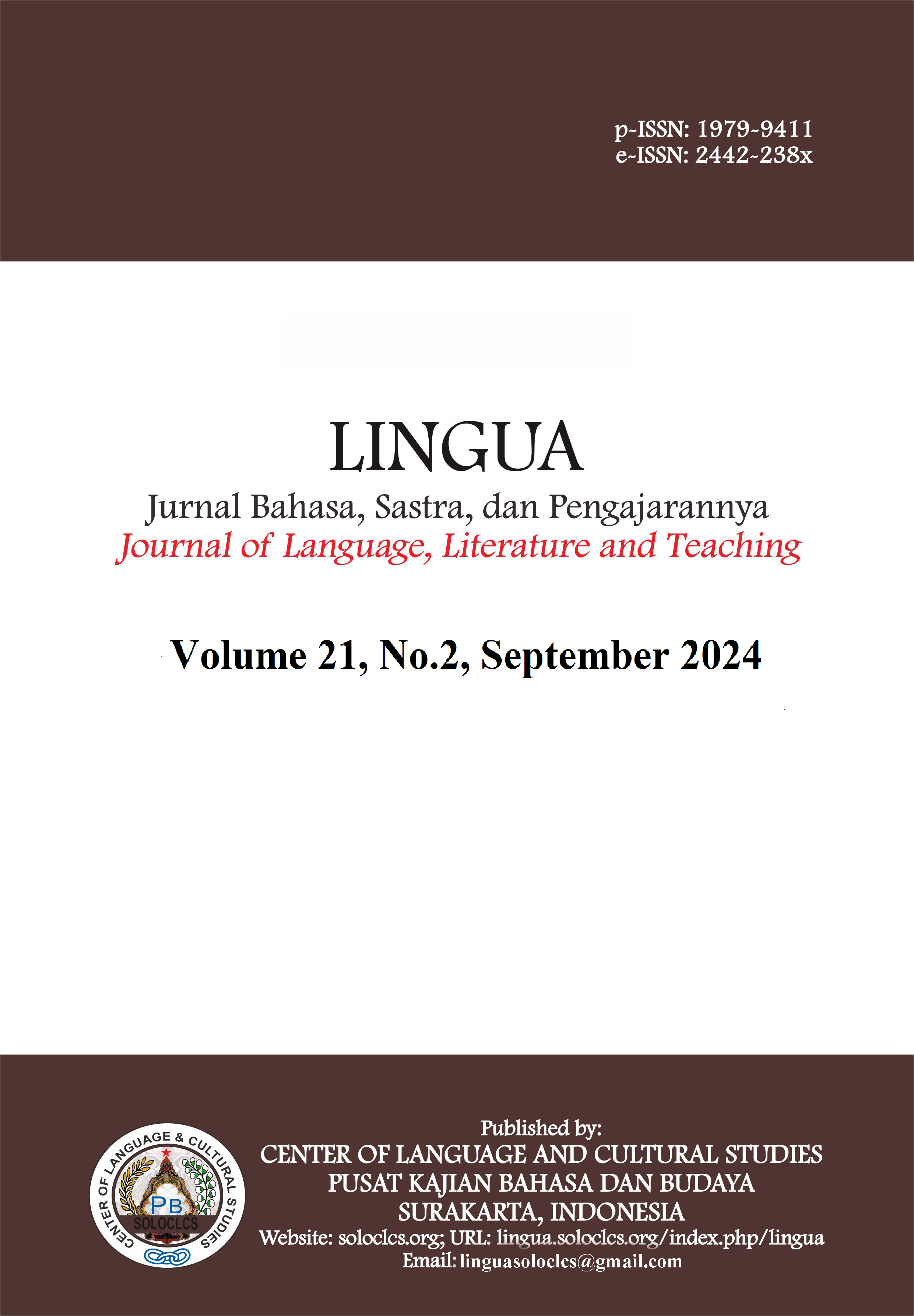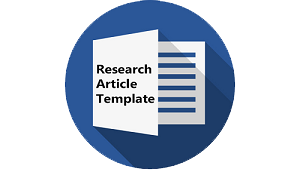The Dynamics Of Bullying Reality In The Movie “From The Ashes”: Teun A.Van Dijk’s Critical Discourse Analysis
DOI:
https://doi.org/10.30957/lingua.v21i2.1055Keywords:
Bullying, Critical Discourse Analysis, From The AshesAbstract
Bullying is a social problem that often occurs, especially in educational settings. Bullying can have an impact on the victim's psychological condition, mental, physical, and emotional control. This research was conducted to describe the text structure, social cognition, and social context using Van Dijk's critical discourse analysis model in the movie “From The Ashes”. This research uses a qualitative descriptive method. The data sources are divided into primary data sources in the form of the movie “From the Ashes” and secondary data sources, in the form of supporting data from several literature sources, journals, and materials from the internet related to the topic of study. This research uses the techniques of watching, reading, and taking notes to collect data. The analysis techniques used are data reduction, data presentation, and conclusion. The results of this study are: (1) The text structure consists of macro-structure elements in the form of themes raised, namely the issue of bullying, superstructure in the form of the plot of this film, and micro-structure focusing on semantic aspects, namely setting, details, and intent. (2) Social cognition that shows the director's views regarding social discourse in the Arab educational environment related to the issue of bullying and discipline in schools. (3) Social context that brings people's views that bullying cases in the educational environment, especially among teenagers, still occur.
Downloads
References
Asnawi, M. H. (2019). Pengaruh Perundungan Terhadap Perilaku Mahasiswa. Jurnal Sinestesia, 9(1), 33–39. https://sinestesia.pustaka.my.id/journal/article/view/46
Alsehaimi, A. (2023). Effects of Bullying on School Students in Saudi Arabia. Effects of Bullying on School Students in Saudi Arabia, 61(61). https://doi.org/10.55463/hkjss.issn.1021-3619.61.55
Erina, A., Nadhirah, N. A., & Ipah, S. (2023). Identifikasi fenomena perilaku bullying pada remaja. Jurnal Bimbingan Dan Konseling, 3, 19–30. https://jurnal.stkipmb.ac.id/index.php/jubikops/article/view/201/152
Fayruza, A. Z., Mahliatussikah, H., & Al Hayani, M. K. K. (2021). Critical Discourse Analysis of Teun A. Van Dijk’s Model against Online News “The Decline in Refinery Profits Threatens to Increase Oil Prices.” Izdihar : Journal of Arabic Language Teaching, Linguistics, and Literature, 4(3), 275–290. https://doi.org/10.22219/jiz.v4i3.18274
Hafizah, Rasyid, Y., & Anwar, M. (2022). Analisis Wacana Kritis Model Van Dijk pada Berita Online Kasus Perundangan dan Pelecehan Seksual di KPI. Diglosia, 6(1), 31–44.
Hanani, A., & Piskin, M. (2020). Gender Difference and Bullying among Secondary School Students in Palestine. 95–100. https://doi.org/10.4236/ojd.2020.94009
Imam, A. F. (2012). Analisis Wacana Van Dijk Pada Lirik Lagu Irgaa Tani (My Heart Will Go on). Lisanul’ Arab: Journal of Arabic Learning and Teaching, 1(1), 1–8.
Jufanny, D., & Girsang, L. R. (2020). Toxic Masculinity dalam Sistem Patiarki: Analisis Wacana Kritis Van Dijk dalam Film “Posesif.” Semiotika, 14(1), 8–23. http://journal.ubm.ac.id/
Juwita, V. R., & Kustanti, E. R. (2018). PSIKOLOGIS PADA KORBAN PERUNDUNGAN. 7(Nomor 1), 274–282.
Nur Ellya, F., Yarno, Y., & Fatin, I. (2023). Pemberitaan Tragedi Kanjuruhan Dalam Tayangan Youtube Narasi Mata Najwa: Analisis Wacana Kritis Van Dijk. Semantik, 12(2), 203–220. https://doi.org/10.22460/semantik.v12i2.p203-220
Nurlaily, A. S. (2019). Unsur Seksualitas Yang Direpresentasikan Tokoh Novel Pasung Jiwa Karya Okky Madasari: Analisis Wacana Kritis Teun a. Van Dijk. METASASTRA: Jurnal Penelitian Sastra, 11(2), 145. https://doi.org/10.26610/metasastra.2018.v11i2.145-156
Qaiser, Q., Khan, D. M. A., & Hassan, S. (2024). A Critical Analysis of Power Dynamics in Bullying Discourse of the Film Bully. 10(2), 136–143.
Ratnaningsih, D. (2019). Analisis Wacana Kritis Sebuah Teori dan Implementasi. https://repository.umko.ac.id/id/eprint/16/1/Buku - Analisis Wacana Kritis %28Teori dan Implementasi%29.pdf
Rizki, A. V., Sahda Brahmasta, N., Fergiansyah, R., & Satvikadewi, A. A. I. P. (2024). Skena Musik Independen Indonesia Analisis Wacana Kritis Van Dijk Pada Komentar Video Clip Lagu “Runtuh”-Feby Putri Ft Fiersa Besari. Jurnal Ilmu Komunikasi Dan Sosial, 2(3), 220–227. https://doi.org/10.59581/harmoni-widyakarya.v2i3.3812
Sarasati, R. (2020). Analisis wacana kritis dalam pembelajaran: Peran AWK pada pembelajaran literasi kritis, berpikir kritis, dan kesadaran berbahasa kritis. Humanika, 19(1), 20–29. https://doi.org/10.21831/hum.v19i1.30156
Selian, S. N., Putri, W., & Restya, D. (2024). Peran Kepala Sekolah dalam Mengatasi Bullying di Sekolah. 9(2), 531–539.
Silaswati, D. D. (2019). Analisis Wacana Kritis Dalam Pengkajian Wacana. METAMORFOSIS | Jurnal Bahasa, Sastra Indonesia Dan Pengajarannya, 12(1), 1–10. https://doi.org/10.55222/metamorfosis.v12i1.124
Sulistiawan, M. J., Afriliana, V. A., & Baehaqie, I. (2024). Analisis Wacana Kritis Model Van Djik Pada Sambutan Joko Widodo pada Pembukaan Kongres XXIII PGRI Tahun 2024. Jurnal Onoma: Pendidikan, Bahasa, Dan Sastra, 10(2), 1683–1693. https://doi.org/10.30605/onoma.v10i2.3582
Syawitri, M. (2024). Peran Keluarga dalam Mencegah Perilaku Bullying: Upaya Kolaboratif dengan Sekolah dan Pemerintah. A-Amin: Jurnal Ilmu Pendidikan Dan Sosial Humaniora, 1(2), 171–178.
Downloads
Published
How to Cite
Issue
Section
License
Copyright (c) 2025 LINGUA : Jurnal Bahasa, Sastra, dan Pengajarannya

This work is licensed under a Creative Commons Attribution-ShareAlike 4.0 International License.
Authors who publish with this journal agree to the following terms:
- Authors retain copyright and grant the journal right of first publication with the work simultaneously licensed under a Creative Commons Attribution-ShareAlike 4.0 International License that allows others to share the work with an acknowledgement of the work's authorship and initial publication in this journal.
- Authors are able to enter into separate, additional contractual arrangements for the non-exclusive distribution of the journal's published version of the work (e.g., post it to an institutional repository or publish it in a book), with an acknowledgement of its initial publication in this journal.
- Authors are permitted and encouraged to post their work online (e.g., in institutional repositories or on their website) prior to and during the submission process, as it can lead to productive exchanges, as well as earlier and greater citation of published work (See The Effect of Open Access).















